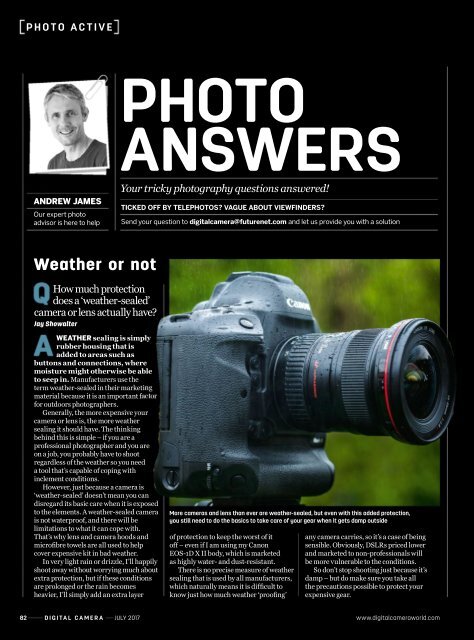Digital_Camera_World_Issue_192_July_2017
You also want an ePaper? Increase the reach of your titles
YUMPU automatically turns print PDFs into web optimized ePapers that Google loves.
Photo Active<br />
Photo<br />
answers<br />
aNDreW JaMeS<br />
Our expert photo<br />
advisor is here to help<br />
Your tricky photography questions answered!<br />
Ticked off by TelephoTos? Vague abouT Viewfinders?<br />
Send your question to digitalcamera@futurenet.com and let us provide you with a solution<br />
Weather or not<br />
How much protection<br />
does a ‘weather-sealed’<br />
camera or lens actually have?<br />
Jay Showalter<br />
Weather sealing is simply<br />
rubber housing that is<br />
added to areas such as<br />
buttons and connections, where<br />
moisture might otherwise be able<br />
to seep in. Manufacturers use the<br />
term weather-sealed in their marketing<br />
material because it is an important factor<br />
for outdoors photographers.<br />
Generally, the more expensive your<br />
camera or lens is, the more weather<br />
sealing it should have. The thinking<br />
behind this is simple – if you are a<br />
professional photographer and you are<br />
on a job, you probably have to shoot<br />
regardless of the weather so you need<br />
a tool that’s capable of coping with<br />
inclement conditions.<br />
However, just because a camera is<br />
‘weather-sealed’ doesn’t mean you can<br />
disregard its basic care when it is exposed<br />
to the elements. A weather-sealed camera<br />
is not waterproof, and there will be<br />
limitations to what it can cope with.<br />
That’s why lens and camera hoods and<br />
microfibre towels are all used to help<br />
cover expensive kit in bad weather.<br />
In very light rain or drizzle, I’ll happily<br />
shoot away without worrying much about<br />
extra protection, but if these conditions<br />
are prolonged or the rain becomes<br />
heavier, I’ll simply add an extra layer<br />
more cameras and lens than ever are weather-sealed, but even with this added protection,<br />
you still need to do the basics to take care of your gear when it gets damp outside<br />
of protection to keep the worst of it<br />
off – even if I am using my Canon<br />
EOS-1D X II body, which is marketed<br />
as highly water- and dust-resistant.<br />
There is no precise measure of weather<br />
sealing that is used by all manufacturers,<br />
which naturally means it is difficult to<br />
know just how much weather ‘proofing’<br />
any camera carries, so it’s a case of being<br />
sensible. Obviously, DSLRs priced lower<br />
and marketed to non-professionals will<br />
be more vulnerable to the conditions.<br />
So don’t stop shooting just because it’s<br />
damp – but do make sure you take all<br />
the precautions possible to protect your<br />
expensive gear.<br />
82 <strong>Digital</strong> <strong>Camera</strong> july <strong>2017</strong> www.digitalcameraworld.com


















